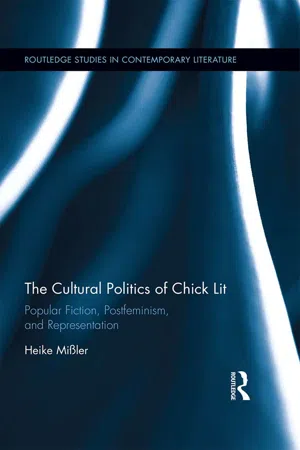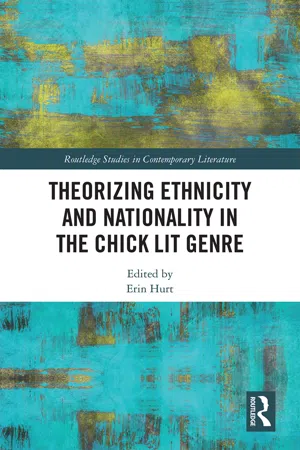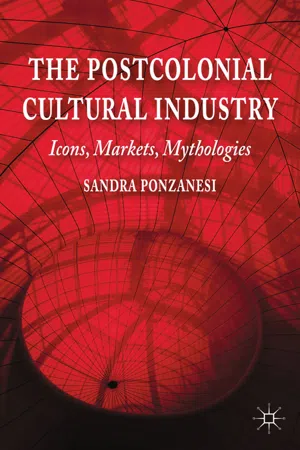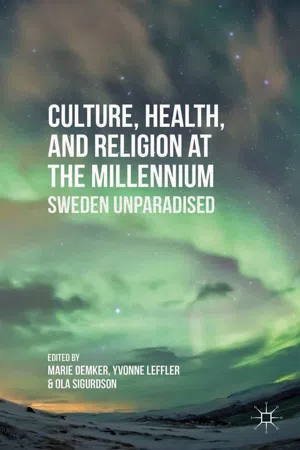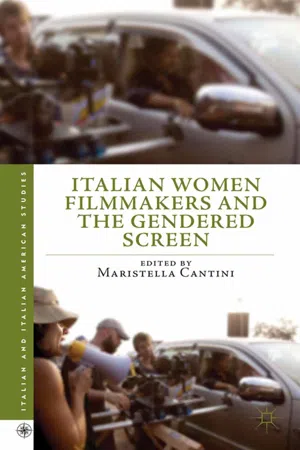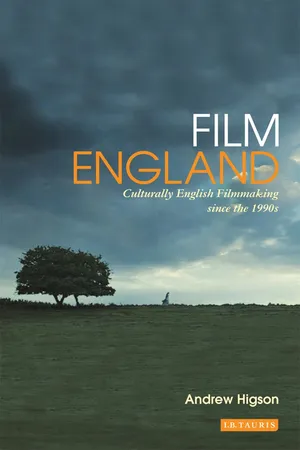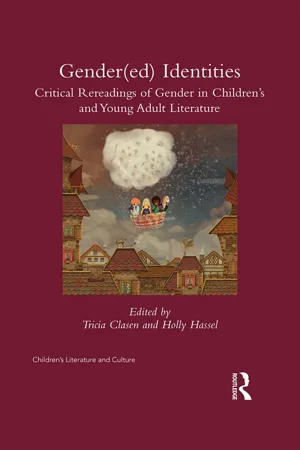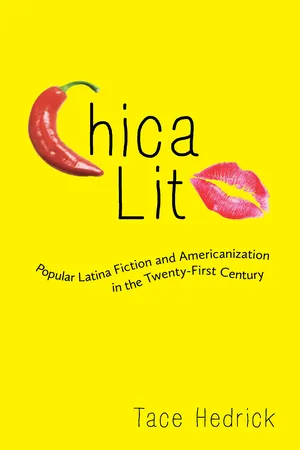Literature
Chick Lit
Chick Lit is a genre of fiction that typically features young, single, urban women as protagonists. The stories often revolve around their romantic relationships, career struggles, and personal growth. The term "Chick Lit" is often used in a derogatory manner, but the genre has gained popularity and has been embraced by many readers.
Written by Perlego with AI-assistance
Related key terms
Related key terms
1 of 4
Related key terms
1 of 3
11 Key excerpts on "Chick Lit"
- eBook - ePub
The Cultural Politics of Chick Lit
Popular Fiction, Postfeminism and Representation
- Heike Missler(Author)
- 2016(Publication Date)
- Routledge(Publisher)
L: Chick Lit is powerful, female fiction that tackles tough topics in a normally light hearted and careful way. It gives women a release and an escape from their everyday live. It is empowering and an extremely important genre.For two other bloggers who answered my survey, having a female lead character and being “interesting” to women (though no elaboration was given on why or how the texts are considered to be interesting to women), suffices for the classification of a novel into the chick-lit genre. However, all the others were more specific in their definitions and stress the diversity and the development of the genre, and its difference from other romantic fiction.C: I define Chick Lit as literature, either fiction or non-fiction, aimed at a female audience, ages 20 - 50 (in my opinion). Chick Lit writing is often humorous with quirky main characters. Chick Lit books generally explore issues that women in this age group would encounter, such as finding love, diet, exercise, choosing a career, becoming more assertive, etc. There is an incredibly wide selection of books considered Chick Lit, ranging from light- hearted, cute novels about dating, shoe shopping and running cupcake shops, to more weighty, dramatic novels about marriage, death, infidelity, and more.S: The main character must be female and older than 18. Setting must be in contemporary times (we do go back to about the 1980s). Chick Lit, not traditional romance (which is all about girl meets boy, Chick Lit includes the other aspects of her life).So even though the bloggers’ definitions vary, these different personal approaches neither weaken the sense of community nor the validity of their canon or the criteria for their reviews, because Chick Lit as a genre can accomodate all of these definitions. The responses also show that there is an awareness that Chick Lit has been artificially created as a marketing label, and that the power to decide what to understand by it lies very much in the hands of the fans. In the end, it is up the individual blogger which texts she chooses to include, how she argues that they belong to the chick-lit canon or not, and how she assesses them as such. - Erin Hurt(Author)
- 2018(Publication Date)
- Routledge(Publisher)
The phenomenon of Chick Lit, which includes both its emergence into the commercial realm and the multiplicity of ethnic categories it has come to include, deserves critics’ attention because this genre offers readers representations of women not seen before. These representations reflect the anxieties, opportunities, and possibilities of the present cultural moment in which women find themselves, almost as if women’s emotional, psychological, and economic struggles induced the novels that marked the commencement of this genre. Elsewhere, Imelda Whelehan articulates the underlying dilemma that these often-humorous novels probe, which is also one of the reasons readers found them appealing, writing, “today’s young women are burdened by the freedoms won by feminism and are, in fact, looking for a sense of order or some ‘rules’ that at least might bring some logic to their romantic lives” (5). Chick Lit functions as a site where women can see the reality of their lives, and when this genre first appeared in England and the US during the 1990s, readers were drawn to literature that finally seemed to depict the challenges they faced. Though many Chick Lit novels drew from conventions found in earlier women’s writing (such as marriage plots, confessional narrators, a diary format, the sex lives of single women, finding romance), they did so in a way that used these conventions to speak specifically to women’s experiences in the late twentieth and early twenty-first centuries.Chick Lit, at its moment of conception, told the story of women attempting to achieve—or perhaps simply define—success in the areas of romance, friendships, a career, and beauty. While not new, this narrative appealed to readers because of how it was told. They found appealing not just the first-person narration, the protagonist’s relatability, or even her search for the perfect happily ever after but the less obvious elements these novels divulged: the impediments that kept women from finding love, achieving professional success, understanding their ethnic identity, or negotiating multiple cultural and/or national communities. This was a time when women were being told by the media and popular culture that, post-Women’s Movement, they could “have it all”—a professional career, a successful marriage, children, beauty, intelligence, a good salary with benefits, and cultural belonging and acceptance—but many women, women of color especially so, quickly discovered that “having it all” was often unachievable. Chick Lit offered readers fictional heroines who attempted, often in humorous and relatable ways, to navigate this landscape where the promise of equality and opportunity did not match the actuality of a patriarchal, classist, and racist society. These depictions validated readers’ experiences by mirroring their frustrations and confusion.- eBook - ePub
The Postcolonial Cultural Industry
Icons, Markets, Mythologies
- S. Ponzanesi(Author)
- 2014(Publication Date)
- Palgrave Macmillan(Publisher)
vis á vis issues of feminist empowerment considering its entanglement with postcolonialism and the cultural industry.6.1.1 What is Chick Lit?Chick Lit has received both scathing criticism and utter adoration from its fans, the chickerati. Critics disdain it because they consider it ‘frilly’, ‘trash’, ‘fluffy’, ‘mind-numbing garbage’ or ‘formulaic vapid prose’. And yet, the emergence of Chick Lit is an interesting new phenomenon, as it is not only market driven but also engages with complex or contestable forms of feminist empowerment. It is not only that it is written by women for women, but also that it addresses pressing issues for women such as career, sexuality and desire.The term was inadvertently coined by novelist Cris Mazza in 1995, when co-editing a volume entitled, ironically and polemically, Chick-Lit: Postfeminist Fiction (1995), which was followed by another co-edited volume, Chick-Lit: No Chick Vics (1996). Cris Mazza was the first to use the term ‘Chick Lit’ in print, but it was used ironically. She could not have anticipated that her mocking use of the term would later re-emerge as a kind of brand name in the publishing industry, which soon spread to denote also chick movies and TV series, and a chick culture in its own terms.2From the literary criticism perspective, we can define it as a form of women’s fiction on the basis of the subject matter, character, audience and narrative style. As Heather Cabot defines it, ‘Simply put, Chick Lit features single women in their twenties and thirties “navigating their generation’s challenges of balancing demanding careers with personal relationships” ’ (Cabot 2003). They are ‘formula stories’ about women, usually singletons, living in urban centres such as London, Manhattan or Dublin, with challenging careers, often in publishing, television or journalism (with some exceptions in the legal profession such as Ally McBeal and Legally Blonde). These are women battling with Harlequin’s ideas of romantic love and the need to experiment with multiple sexual partners (as in Sex and the City - eBook - ePub
Culture, Health, and Religion at the Millennium
Sweden Unparadised
- M. Demker, Y. Leffler, O. Sigurdson, M. Demker, Y. Leffler, O. Sigurdson(Authors)
- 2014(Publication Date)
- Palgrave Macmillan(Publisher)
Therefore, I aim to study Swedish Chick Lit as a source of sociocultural commentary. The purpose of this essay is to examine the differences between Anglophone and Swedish Chick Lit when it comes to ethical and social questions and ideas about happiness, well-being, and everyday life. I will examine how Swedish Chick Lit, on one hand, conforms to the Anglophone “Chick Lit formula” and, on the other hand, conveys both an ambiguous and rather different message. Although Chick Lit is famous for its focus on a stylish, professional, middle-class woman, her shopping, boyfriends, and sex, I reject these stereotypes and intend to redefine Swedish Chick Lit as a genre that teaches its female audience how to deal with much more serious matters, such as personal crises; family problems; and also various mental problems, such as depression and feelings of inferiority. It is not so much about how to achieve a glamorous romantic lifestyle, as it is about how to effectively apply necessary life strategies—that is, how to get on with ordinary everyday life as such. In that way, Swedish Chick Lit novels are part of today’s self-help industry, using the “makeover” formula. At the same time, they rely on a long tradition of manuals of manners for women, dating back to the eighteenth century.Chick Lit and Women’s FictionChick Lit belongs to what is called women’s fiction, an umbrella term for a wide-ranging collection of literary subgenres that, besides Chick Lit, also includes romance, romantic comedies, and female gothic. The term is used to refer to the type of popular fiction that targets female readers. When it is applied to novels, they are often considered to be stories about women and women’s issues, written by women writers for women readers. Compared to most romance literature, Chick Lit is about a slightly older woman: a single, professional protagonist in her thirties, sometimes in her late twenties or early forties. The novels illustrate what happened after Cinderella was united with the prince and the difficulties she confronted when she was supposed to live happily ever after. Many narratives start when the heroine is dumped by Prince Charming and has to face new challenges as well as a variety of romantic, personal, and professional dilemmas. Still, most Chick Lit novels are structured according to the romance formula. They tell the story of the female character’s meeting with a new and better man and the unfolding of their romantic relationship. They often contain what Pamela Regis calls the eight narrative elements of romance novels: “a definition of society, always corrupt, that the romance novel will reform; the meeting between the heroine and hero; an account of their attraction for each other; the barrier between them; the point of ritual death; the recognition that fells the barrier; the declaration of heroine and hero that they love each other; and their betrothal.”2 - eBook - ePub
Chick Lit
The New Woman's Fiction
- Suzanne Ferriss, Mallory Young(Authors)
- 2013(Publication Date)
- Routledge(Publisher)
Novelist Cris Mazza, coeditor of Chick-Lit: Postfeminist Fiction (FC2, 1995) and Chick-Lit: No Chick Vics (FC2, 1996), argues convincingly that she was the first to use the term “Chick Lit” in print—but for ironic purposes. In “Who’s Laughing Now?: A Short History of Chick-Lit and the Perversion of a Genre,” she traces how the term worked its way into print after her anthologies were published and reviewed, focusing on the difference between her mocking use of “Chick Lit” and its subsequent emergence as a type of brand name in the publishing industry. In the ten years since Mazza and her coeditor Jeffrey DeShell first used the term, Chick Lit has acquired a fixed definition, mocked not only in the “Chick Lit 101” article but also in various recipes and formulas published in the popular press. From the perspective of literary criticism, we can define it as a form of women’s fiction on the basis of subject matter, character, audience, and narrative style. Simply put, Chick Lit features single women in their twenties and thirties “navigating their generation’s challenges of balancing demanding careers with personal relationships” (Cabot). As popular women’s fiction, Chick Lit has been likened to the contemporary romance popularized by Harlequin in the United States and Mills and Boon in Britain. 1 But here, too, the connection might be an ironic one. Janice Radway’s influential work on the romance identifies that genre’s single unassailable tenet: the primacy of the male-female couple. The heroine must be connected with one, and only one, man. Yet, as Stephanie Harzewski explains in her essay “Tradition and Displacement in the New Novel of Manners,” that requirement, along with others, has been subtly subverted by chick-lit novels - eBook - ePub
- Maristella Cantini(Author)
- 2013(Publication Date)
- Palgrave Macmillan(Publisher)
Stephanie Harzewski explores the dynamics behind “Chick Lit” as a genre that has generated a strong polemic among well-established women writers (from George Eliot to Doris Lessing, just to give an idea of the time-range). They, legitimately, feared the generalization and marginalization of their roles as artists and intellectuals, which they perceived threatened, if not endangered, by products of popular culture. Harzewski (2011: 2) also points out the increasing proximity between Chick Lit and cinema, explaining that the “Chick Lit genre is best exemplified by HBO’s series Sex and the City.” 9 The extraordinary number of film studies publications invigorating the academic discussion since the late 1970s and 1980s demonstrates, in my opinion, that feminism’s legacy is operating on multiple cultural levels, inducing scholars to investigate popular culture as a significant field of inquiry. Therefore books, magazines, TV shows and series, movies, blogs, and websites have been closely monitored by feminist media critics in order to assess their impact on contemporary culture. Reading between the lines of pink-covered bestsellers or glossy magazines may result in a plurality of messages, often old fashioned and conservative, aiming to restore women’s role to being confined to areas of minimum control, such as the domestic and private arena. I do believe that Chick Lit, and therefore many “Chick Flicks,” can contain subversive narratives that corrode and perhaps even redefine social order. In the attempt to delineate the blurred edges between women’s film and films for women, and to distinguish categories of movies that actually rejected women’s emancipation versus those that opened possibilities for new roles and a more progressive inscription of women in cinema and society, many scholars focused their research on the wide open category of women’s 6films. 10 Charlotte Brundson wrote Films for Women (1986). B. Ruby Rich entitled her book Chick Flicks - eBook - ePub
Film England
Culturally English Filmmaking Since the 1990s
- Andrew Higson(Author)
- 2010(Publication Date)
- I.B. Tauris(Publisher)
All of these titles are examples of the publishing and film businesses exploiting new markets in the 1990s and early 2000s: on the one hand the crossover product, which has the capacity to shift out of a niche market into the mainstream; and on the other hand Chick Lit, or the ‘city girl’ novel, as represented by the Bridget Jones franchise. Like Chick Lit’s masculine variant, lad lit, these were generic categories that emerged in the 1990s and were carefully nurtured by the publishing business and subsequently by film distributors. Behind these relatively new developments is a more established context in which fictional experiences are sold to consumers. Traditionally, there are two relatively distinct markets for both novels and films – and the distinctions between them are routinely upheld by critics.On the one hand, there is what is often dismissed as mass-market genre fiction, the best-seller, the novel as popular culture – or what in film terms can be described as the multiplex market. This in turn can be further subdivided by genre and consumer base. Thus there are the primarily action-based genres, which tend to be popular with male readers, and in due course cinema-goers. And there is women’s romance fiction, which has not in recent years been much taken up by the film industry. Hence the significance of both the Chick Lit phenomenon and the crossover success of titles by the likes of Joanne Harris, which can work both as serious literature and as romance fiction. Mass-market genre fiction tends to be judged primarily in terms of sales and fan bases, or readerships. It is often assumed to be less reflective about its own form, its subject matter, and the world in which it is set. But often so-called genre fiction can be self-conscious about both form and content – and critics will claim that writers such as Ruth Rendell, John le Carré and P.D. James rise above the constraints of their genres. Such debates mirror closely the debates about popular cinema.At the other end of the market is the so-called serious novel, self-consciously literary fiction for ‘middle to highbrow’, ‘discriminating readers’.18 This is the arena of prize-winning fiction and the so-called ‘literary novelist’, who specialises in slow-moving character studies rather than narratives of action, and in the novel of ideas. This is the literary equivalent of art-house cinema and the festival circuit, with its own system of prizes and awards that validate the film business’s sense of quality and specialised niche markets. As with literary culture, it is a market traditionally defined less in terms of commercial success and more in terms of critical impact and reputation, with the reviewing practices - eBook - ePub
Reading New India
Post-Millennial Indian Fiction in English
- E. Dawson Varughese(Author)
- 2013(Publication Date)
- Bloomsbury Academic(Publisher)
3 Chick Lit to crick litChapter 3 investigates the rise in Chick Lit and crick lit (my term) narratives. Advaita Kala’s Chick Lit novel Almost Single (2007) is a seminal work in the evolution of Chick Lit within the Indian publishing scene. Her book explores what it is to be young and female in India today and this novel is analysed along with Chauhan’s Battle for Bittora (2010), a novel that brings the Chick Lit genre together with a political narrative and contemporary boy-meets-girl plot. Section 3.2 considers the recent body of fiction on cricket, ‘crick lit’ as I term it, and this presentation includes analysis of The Premier Murder League (2010) by Geeta Sundar and The Zoya Factor (2008) by Anuja Chauhan.3.1 Chick LitToday’s body of writing that we might call ‘Chick Lit’ is mainly written by women, with a female protagonist who, in various ways, faces challenges, questions and changes in contemporary Indian society, these narratives often include a ‘love’ or ‘romance’ element and are often narrated humourously. However, there are a few exceptions, see: With or Without You (2010) by Partha Sarathi Basu, Love Over Coffee (2010) by Amrit N. Shetty and Chocolate Guitar Momos (2011) by Kenny Deori Basumatary. These male-authored narratives, although stories of ‘romance’ (in various guises), have less emphasis on the female protagonist as they are told from the male perspective.Today’s canon of Chick Lit might be considered alongside female narratives that have been published earlier in the history of writing in English in India. The work of Shashi Deshpande, Anita Desai, Shama Futehally, Temsula Ao, Nisha da Cunha, Kamala Markandaya as well as other women writers with recent novels in publication such as Jaishree Misra and Manju Kapur, all have engaged with female narratives. Lau (2006) writes of the emotional and domestic territories which are so often explored in the fiction of these writers, stating: ‘their writings frequently include detailed descriptions of the interior spaces of home, the negotiation of roles and hierarchies, and the emotional lives played out against a background of the bedroom and the kitchen’ (Lau - eBook - ePub
Gender(ed) Identities
Critical Rereadings of Gender in Children's and Young Adult Literature
- Tricia Clasen, Holly Hassel, Tricia Clasen, Holly Hassel(Authors)
- 2016(Publication Date)
- Routledge(Publisher)
Horn Book Magazine 80, no. 6 (November 2004): 669–77, 670.- 3. Joanna Webb Johnson, “Chick Lit Jr.: More than Glitz and Glamour for Teens and Tweens.” In Chick Lit: The New Woman’s Fiction. Edited by Suzanne Ferris and Mallory Young, 141–58 (New York and London: Routledge, 2006), 146.
- 4. As Webb Johnson points out, however, critics disagree on the orthodoxy of the feminist discourses of adult Chick Lit. My point, here, is not to debate whether that genre is feminist, but rather to show that criticism of teen Chick Lit tends to take the position that it is less feminist than its adult version.
- 5. Joanna Webb Johnson has noted that in adult Chick Lit, “the characters often seem to be adolescent in at least one aspect of their lives” and that “both versions of the genre usually feature stages of emotional and sexual maturity for their protagonists or, at their best, a grand moment of self-realization.” Webb Johnson, “Glitz and Glamour,” 142.
- 6. Sarra Manning, Guitar Girl (New York: Penguin, 2005 ), 9.
- 7. Manning, 25.
- 8. Gérard Genette defines the paratext as “what enables a text to become a book and to be offered as such to its readers and, more generally, to the public.” Gérard Genette, Paratexts: Thresholds of Interpretation. Trans. Jane E. Lewin (Cambridge: Cambridge University Press, 1997), 1.
- 9. Gérard Genette, Paratexts, 135.
- 10. These musicians are also named by Jennifer Baumgardner and Amy Richards, authors of Manifesta, as icons of third-wave feminism with whom they feel affiliated. Manifesta’s relationship to third-wave feminism will be detailed below.
- 11. Yvonne Tasker and Diane Negra, Interrogating Postfeminism_ Gender and the Politics of Popular Culture
- eBook - ePub
Latinx and Latin American Profiles
Popular Latina Fiction and Americanization in the Twenty-First Century
- Tace Hedrick(Author)
- 2015(Publication Date)
- University of Pittsburgh Press(Publisher)
In addition, Latina characters must face the largely unspoken fact that in real life, Latinas and Chicanas have less opportunity for entrance into well-paying professional careers than do white women. Thus, we must ask ourselves how working (or having a career) functions in chica lit. In her discussion of “career girl” precedents to Chick Lit, Harzewski notes, “A harbinger of the sexual revolution and figurative how-to guide to the best of everything, [former editor of Cosmopolitan ] Helen Gurley Brown’s Sex and the Single Girl (1962) stands, in title and spirit, as a foundational predecessor to the Chick Lit genre. . . . [I]ts rejection of the cultural myth that every girl must be married and its directives for having a fulfilling and romantic, if not enviable, life as a single woman underlie Chick Lit” (141). Although I would argue that neither chick nor chica lit reject “the cultural myth that every girl must be married,” the “directive” that young women who wish to be glamorous must have careers lies at the heart of chica lit’s didactic drive toward cultural Americanization as well. Having the means to consume no longer assumes that a woman will be supported (at least entirely) by a man; and for chica lit having a job, or better yet a career or profession, is of central importance in recouping Latinas as middle-class citizens. Not all chica lit, of course, represents paid work in the same ways. In the novels I examine, issues of work fall into two broad groups. The first group includes the writings of Valdes and Rios as well as Mary Castillo’s Switchcraft : in these, the oft-mentioned assertion that the chica heroine has a career fills in for the lack of scenes of actual work. These novels follow the lead of contemporary women’s popular fiction: Who remembers seeing any of the four girlfriends of Sex and the City actually toiling at their various jobs? Such scenes would work as “downers” for that element of enjoyment these narratives must employ - eBook - ePub
- Luise von Flotow, Luise von Flotow(Authors)
- 2011(Publication Date)
- University of Ottawa Press(Publisher)
SEXUALITY AND FEMININITY IN TRANSLATED CHICK TEXTSAnne-Lise Feral, University of Edinburgh“Bridget Jones’s Diary rings with the unmistakable tone of something that is true to the marrow. It defines what it describes.”—Times Literary Supplement 1“These four TV heroines are the very models of new millennium women . . . which one are you?”—Express on Sunday on the series Sex and the City 2“Bushnell has captured the big, black truth.”—Bret Easton Ellis on the novel Sex and the City 3“A show that a lot of today’s women can relate to.”—A viewer of the series Ally McBeal 4C hick lit novels and chick television series (in short, chick texts) emerged in the mid-to-late 1990s as part of a broader Anglo-American cultural trend about, for and often by young women, informally known as “chicks.” As the quotes above illustrate, chick texts are marketed and often perceived as socially realistic and relevant, or in more academic terms as constituting “socially constructed knowledges of (some aspect of) reality. [They] provide versions of who does what, when and where, [and] add evaluations, interpretations and arguments to these versions” (Kress and Leeuween 2001: 15).Female sexuality is an important topos in these chick texts, and doubtless also a selling feature (Gill and Herdieckerhoff 2006; Kiernan 2006). However, its representation often moves away from what might be considered traditional views of women’s sexuality, focusing instead on assertive women who deliberately seek sex, enjoy sex, act as sexual predators and “behave like men” (Henry 2004; Nelson 2004; Mabry 2006). In the essay that follows, I will explore the representation of these “non-traditional” features of female sexuality in the French translations of four best-selling and record-viewing chick texts: Candace Bushnell’s novel Sex and the City and the first season of its television adaptation; Helen Fielding’s Bridget Jones’s Diary and the first twelve episodes of the television series Ally McBeal
Index pages curate the most relevant extracts from our library of academic textbooks. They’ve been created using an in-house natural language model (NLM), each adding context and meaning to key research topics.
Explore more topic indexes
Explore more topic indexes
1 of 6
Explore more topic indexes
1 of 4
